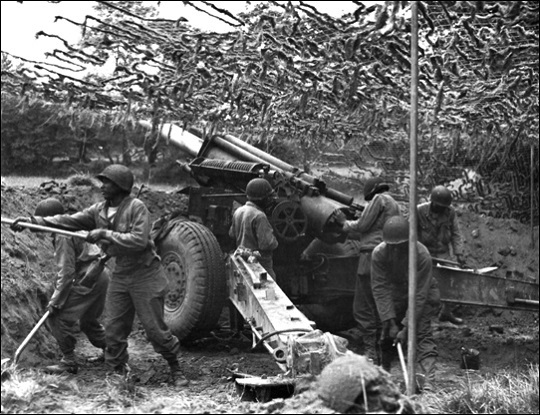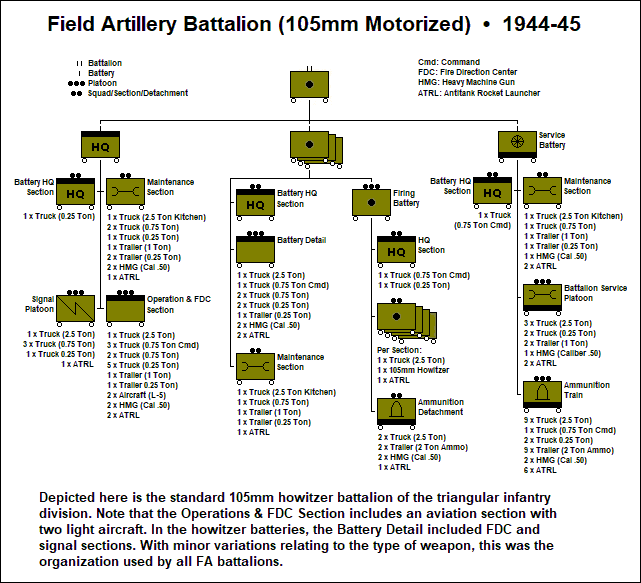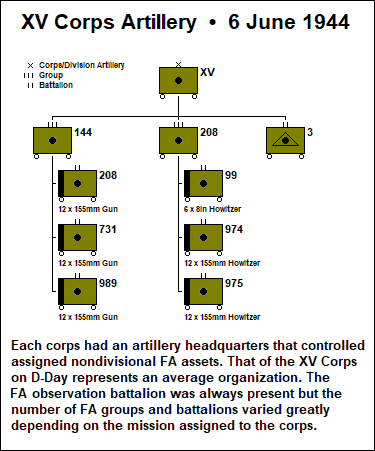Note: At
the beginning of World War II the artillery of the US Army
was divided into two branches: Field Artillery (FA),
nicknamed the Redlegs, and the Coast Artillery Corps (CA),
nicknamed the Cosmoliners. This article covers the FA only.
World War II FA
weapons were of two types: guns and howitzers. The former
were long-range, flat-trajectory weapons; the latter were
medium- to long-range weapons capable of high-trajectory
fire.
● ● ●
When it
was all over, General George S. Patton said, “I do not have
to tell you who won the war. You know. The artillery did.”
There
was some hyperbole in this, but Patton had a point.
Without doubt, the FA was the most impressive branch of the
wartime US Army’s combat arms. Its weapons and equipment
were of the highest quality; its technical and tactical
competence was second to none. The Army had closely studied the lessons of
the Great War, particularly as related to the role of
artillery. When the time came to prepare for a new war, the
organization of the FA was carried out systematically; that
is, instead of thinking in terms of guns, men and units, the
Army created an integrated artillery system.
But without guns there is no
artillery. In the Great War, the FA had been largely reliant
on British and French equipment, especially the M1897 75mm
field gun, the M1917 155mm gun and the M1917 155mm howitzer,
all of French origin. These weapons soldiered on in the
postwar army and saw service in the early days of World War
II, but by then a new range of weapons had been designed to
replace them. The artillery of the infantry division came to
be based on two models: the M2 105mm light field howitzer
and the M1 155mm medium field howitzer. Both were excellent
weapons, destined to serve for many years. Modernized
versions of both still equipped National Guard artillery
units as late as the 1980s.
By 1941
these weapons were well integrated into the Army’s combat
divisions. In 1940-41 the
infantry divisions of the Regular
Army had been reorganized from the World War I-era square
configuration (two infantry brigades, each with two
regiments) to a triangular configuration (three infantry
regiments, each with three battalions). The triangular
division’s artillery component consisted of four separate
FA battalions, three with 12 x 105mm howitzers each, and one
with 12 x 155mm howitzers. There was no regimental
headquarters and the four battalions were controlled by the
Division Artillery (DIVARTY), essentially a brigade-echelon
tactical headquarters. (The infantry divisions of the
National Guard remained in the square configuration until
they were inducted into federal service in 1940-41, at which
time they became triangular.)
In 1941,
armored divisions were organized under what later was termed
the heavy configuration. Their artillery component consisted
of seven batteries, each with 4 x 105mm howitzers, halftrack
towed. Four were under a regimental headquarters in the
division’s armored brigade; the other three were in a separate
battalion. There
was no DIVARTY HQ. In 1942, divisional artillery was
reorganized into three battalions, each with 18 x self-propelled (SP)
105mm howitzers, the regimental HQ was eliminated, and a DIVARTY HQ was provided. When most
armored divisions were reorganized under the 1943 light
configuration, their artillery component remained the same:
three Armored FA Battalions, as by then they were
designated.
The
DIVARTY of airborne divisions had three battalions, each
with 12 x M1 75mm pack howitzers: one designated Parachute FA
Battalion, the other two designated Glider FA Battalion. in
1943-44 a fourth Glider FA Battalion equipped with the M3
105mm light howitzer was attached to some airborne
divisions, and by early 1945 this battalion was present in
all airborne divisions. The two
cavalry divisions in existence in 1941 had three FA
battalions: two with 12 x 75mm howitzers, horse drawn, and
one with 12 x 105mm howitzers, motor towed. Neither division,
however, saw action as horse cavalry during the war.
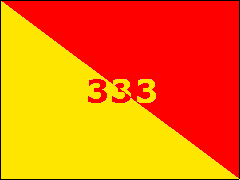
Distinguishing Flag, 333rd
Field Artillery Group (Colored)
The Army's nondivisional artillery consisted mostly of howitzers and
guns with a caliber of 4.5in (115mm) or greater, though
there were some 105mm towed and SP howitzer battalions. Such
units were intended to serve as corps and field army assets,
and at the beginning of the war they were organized as
regiments and brigades. In late 1942, however, the Army
decided to abolish the regimental structure in all branches
but infantry, replacing it with a flexible group
organization. Nondivisional FA regiments were reorganized as
follows (using the 333rd FA Regiment as an example). The
regimental headquarters became Headquarters and Headquarters
Battery (HHB) 333rd FA Group, the 1st Battalion became the
333rd FA Battalion, and the 2nd Battalion became the 969th
FA Battalion. All three were then separate, self-contained units, though
usually the battalions were attached back to the group. An
FA group could control up to four battalions, as did the
333rd FA Group by D-Day. Most FA brigades were inactivated,
though some, already overseas, remained in being.
Nondivisional FA battalions were equipped with the following
weapons: M7 105mm (SP), M1 155mm, M1 8in and M1 240mm
howitzers; M1 4.5in, M1 and M40 (SP) 155mm and M1 8in guns.
The 4.5in and 155mm battalions had twelve guns or howitzers;
the 8in and 240mm battalions had six. A typical allotment of
nondivisional artillery to a corps or field army was VIII
Corps Artillery on 6 June 1944: two FA groups controlling
six FA battalions (155mm and 8in howitzers; 155mm guns) plus
an FA observation battalion (see below).
Unlike
the artillery of the German Army, which remained partly
reliant on horses for mobility, the US Army’s FA battalions
were completely motorized or mechanized. The Armored FA
Battalion’s M7 SP 105mm howitzer (based on a modified M3 or
M4 tank chassis) greatly enhanced the weapon’s mobility and
provided its crew with a measure of armor protection. The
infantry division’s 105mm howitzers were towed by the
ubiquitous 2.5-ton cargo truck; heavier guns by various
models of tractor. A towed 105mm howitzer battery in an
infantry division had 7 x 2.5-ton trucks, 5 x 0.75-ton trucks
(known as the weapons carrier) and 3 x 0.25-ton trucks (the
famous Jeep). There were also five trailers of various cargo
capacities.
The FA system referred to above
integrated the core tasks relating to artillery:
observation, target acquisition, communications and fire
direction. It was this system that made the US Army artillery
so effective in action.
Observation was just that: observing and correcting the fall
of shot to adjust fire onto the target. This was the job of
the FA forward observer (FO) teams. These teams were
attached to infantry and armor units, and linked by radio to
the fire direction center (FDC) of their parent FA
battalion. Their presence on the front line enabled targets
of opportunity to be quickly identified and accurately
engaged: the FA direct support mission.
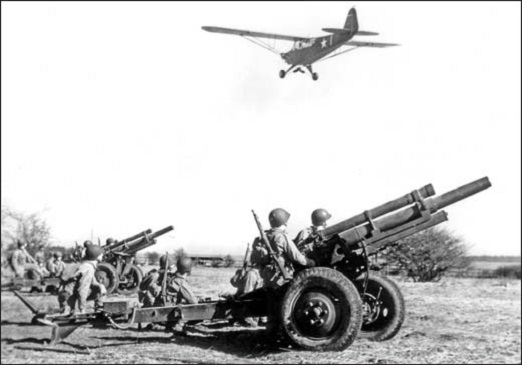
A 105mm howitzer battery
with an aerial observer aircraft overhead (US Army Center of
Military History)
It was
found, however, that insufficient FO teams could be provided
to guarantee timely artillery support for dispersed infantry and armor units
in action. This gap was filled by air observation. In the
infantry and armor DIVARTY, the headquarters and each FA
battalion had an air observation section with two light
liaison aircraft for a total of ten in the infantry
division or eight in the armored division. The aircraft was
either the L-4 Grasshopper, a militarized variant of the
popular Piper J-3 Cub, or the Stinson L-5 Sentinel, purpose
built for the military. Though the Air Corps provided ground
crews and technical support, the air observation sections
were part of the FA, the pilots and observers being FA
officers. The ability to spot targets and call for fire from
the air greatly enhanced the FA’s flexibility.
Despite
its designation, the Field Artillery Observation Battalion
was primarily concerned with target acquisition on behalf of
nondivisional corps artillery. These battalions were
organized with a headquarters battery and two observation
batteries, each of which had a sound ranging platoon and a
flash ranging platoon. The battalion’s missions were
location of hostile artillery, registration and adjustment
of artillery fire, coordination of survey, artillery
calibration, and providing the meteorological message to
supported units.
Secure, rapid communication was
facilitated by the signal units attached at each echelon of
command, providing FA units with their own radio and
telephone nets. The FM radio had been adopted before the war
and it proved very satisfactory in service. DIVARTY
and FA group headquarters maintained a command net linking
to their subordinate battalions, and battalion headquarters
did likewise, linking to their subordinate batteries. Thus
calls for fire from observers and fire orders from higher
headquarters could quickly be passed along the chain of
command.
FA fire
direction had two facets: tactical and technical. Tactical
fire direction was basically the coordination of FA fires
with the division’s tactical planning: identification and
prioritization of targets, preparation of fire plans,
standardization of fire commands, employment of smoke, integration of other assets into fire
planning (e,g. corps artillery battalions, infantry regiment
cannon companies, 4.2in mortar units) and other matters.
Generally this was done in the operations section of the
DIVARTY HQ, though some tasks could devolve on the battalion
fire direction centers (FDC). Since all echelons of command were
linked in a divisional FA radio net, FA fires could be
divided or massed as required. The most fearsome massing of
fires was the time-on-target (TOT) mission, by which the
fires of multiple FA batteries or battalions were timed to strike a
target simultaneously—with devastating effect.
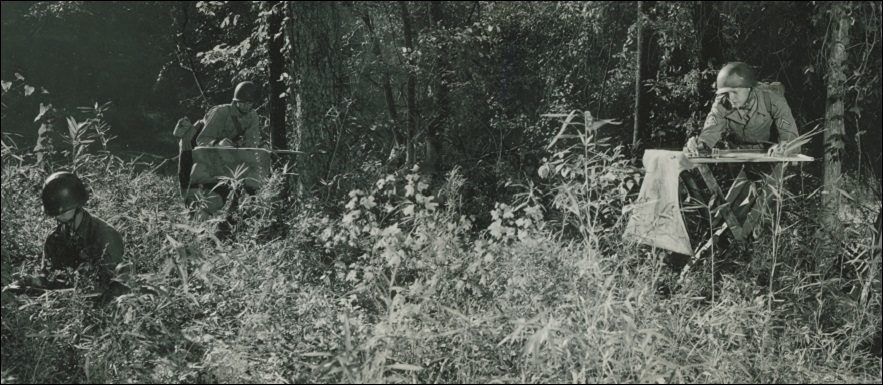
Field training exercise
for a Battery FDC section (National World War II Museum)
Technical fire direction—the actual computation of firing
data for howitzers and guns—was done at the battalion and
firing battery levels. The technical fire direction process
converted range and direction to the target from each
battery position into elevation, deflection and fuse
settings, with such variables as propellant temperature,
meteorological conditions and differences in altitude
between the guns and the target incorporated into the
solution. Standardized procedures enabled this task to be
completed rapidly by well-trained FDC personnel.
Nondivisional FA battalions were
similarly controlled by the corps artillery and FA group HQs
to which there were assigned.
Immediately after the termination
of hostilities in Europe, the General Board, European
Theater of Operations, United States Army, was set up to
conduct a wide-ranging review of the organization,
equipment, and tactical employment of the infantry division
in light of combat experience. The Board's conclusion was
that the wartime triangular infantry division's major
subordinate elements were insufficient to execute
independent combat missions. Its recommendation on the
division artillery was that although its basic structure was
valid, it should be strengthened. This was done by
increasing the firing batteries from four to six howitzers,
for a division total of 54 x 105mm howitzers and 18 x 155mm
howitzers.
Postwar analysis disclosed that in
Tunisia, Sicily, Italy and northwest Europe, some 85-90% of
total casualties inflicted by US forces on the German enemy
were due to artillery fire. Numerous German soldiers, from
enlisted men to senior officers, testified that the FA was
the most feared and respected branch of the US Army. In
World War II, the Redlegs well earned their title: “King of
Battle.”
